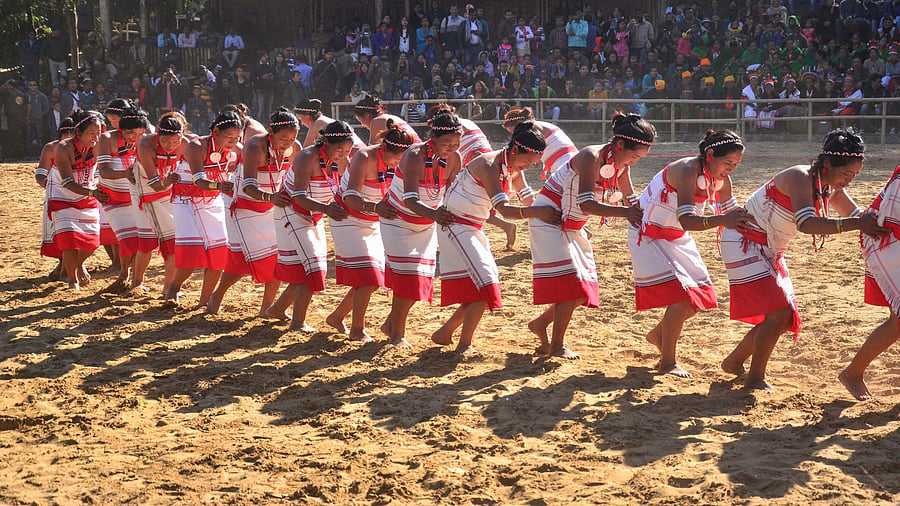
Members of a Naga tribe perform during the Hornbill festival at village Kisama, near Kohima.
Credit: PTI Photo
The Framework Agreement, signed on August 3, 2015, between the Government of India (GoI) and the National Socialist Council of Nagaland-Isak-Muivah (NSCN-IM), marked a significant moment in the attempt to resolve the seven-decade-long Naga political problem.
This was followed by the “Agreed Position” accord with the Naga National Political Groups (NNPGs) on November 17, 2017.
Despite these milestones, the peace process seems precariously close to collapse, with the ceasefire signed in 1997 and numerous rounds of negotiations failing to produce a conclusive resolution. What has led to this impasse? Why does peace remain elusive? To understand these questions, it is imperative to trace the roots of this enduring struggle.
The seeds of Naga political consciousness were sown in 1918 with the formation of the Naga Club in Kohima. Inspired by their experiences during World War I in Europe, the Naga Labour Corps envisioned unity as a people. Their resolve was articulated in a memorandum to the Simon Commission in 1929 at Kohima, urging the British to allow the Nagas to remain independent when the colonisers left the subcontinent.
In 1947, a nine-point agreement between the GoI and the Naga National Council (NNC) proposed “experimental coexistence” with India, with the option for review after ten years. However, miscommunication and mistrust rendered the agreement ineffective.
On July 19, 1947, NNC leader Dr A Z Phizo met Mahatma Gandhi at Balmiki Colony, Delhi, where Phizo declared the Nagas’ intention to proclaim independence on August 14, 1947. Gandhi, after much deliberation, reluctantly accepted this declaration. Following this, the Nagas celebrated their independence day on August 14, 1947.
Subsequent meetings, including one with C Rajagopalachari in 1949 at Shillong, further affirmed their desire for self-determination.
In 1951, a plebiscite was held among the Naga people, with 99.9% voting in favor of sovereignty as claimed by NNC. The results were presented to PM Jawaharlal Nehru in 1952, leading to the boycott of the first and subsequent general elections in Naga areas till 1962. In response, the GoI created Nagaland as a separate state in 1963 to address their aspirations. However, this measure divided the Naga leadership, with hardline nationalists rejecting statehood as a compromise to their sovereignty, resulting in violence and the assassination of moderate leaders.
The 1950s saw militarisation of the conflict. The deployment of Indian armed forces and paramilitary units escalated violence, compelling the Nagas to form the Naga Home Guard. This period was marked by widespread human rights abuses, including killings, destruction of property, and war crimes. The fragile ceasefire in 1964 and the Shillong Accord of 1975 were short-lived. A lasting peace remained elusive until the signing of a ceasefire between the GoI and NSCN-IM on July 25, 1997. Yet, even after the ceasefire, the road to a permanent settlement has been fraught with distrust and division.
Divergent interpretations
The enduring stalemate reflects deep-rooted historical grievances, divergent interpretations of sovereignty, and the lack of consensus among Naga factions. Resolving the conflict demands a nuanced approach, balancing the aspirations of the Naga people with the sovereignty of the Indian state while fostering unity among all stakeholders.
Upon examining the Framework Agreement, it becomes clear that India’s recognition of the Nagas’ unique history and position reflects the country’s broader commitment to its diverse linguistic, cultural and religious heritage. This acknowledgment is consistent with the values extended to other diverse groups within India. However, the NSCN-IM’s interpretation of this recognition as equivalent to acknowledging a separate Naga nation has been firmly rejected by the GoI, which views such an interpretation as misaligned with the agreement’s intent and India’s Constitution.
Examining a key statement in the Framework Agreement: “Both sides have understood each other’s respective positions and are cognisant of the universal principle that in a democracy sovereignty lies with the people. Accordingly, the Government of India and NSCN, respecting people’s wishes for sharing the sovereign power as defined in the competencies, reached an agreement on August 3, 2015, as an honorable solution.”
The term “competencies” remains undefined, leaving the scope of the agreement open to varied interpretations. This lack of clarity has led to a divergence of understanding between the Government of India and the NSCN-IM, preventing a cohesive resolution. Furthermore, sovereignty in all Indian states is inherently vested in the people, making it essential for the NSCN-IM’s interpretation of shared sovereignty to align with the broader constitutional framework upheld by the GoI.
Over the past decade, ideological rigidity from both the GoI and the NSCN-IM has stalled progress on resolving the Naga political problem. The GoI’s focus on promoting a homogenised national identity — emphasising Hindutva, Hindi, and a centralised federal structure — has alienated the Nagas, who value their distinct identity.
Meanwhile, the NSCN-IM’s insistence on an independent Naga nation with a separate flag and constitution has similarly hindered negotiations. A pragmatic middle ground is essential for resolution.
India’s Constitution, with its inherent flexibility to embrace diversity, can provide a framework for coexistence. Recognising the Naga flag alongside the Indian national flag, akin to Karnataka’s dual-flag practice, could honor the Nagas’ aspirations without compromising India’s sovereignty. The proposed “Yehzabo” (Naga constitution) could be integrated into India’s legal framework through constitutional amendments, preserving Naga traditions while aligning with Indian law. Furthermore, Article 3 of the Constitution could facilitate the integration of Naga-majority areas from neighboring states into Nagaland, addressing territorial aspirations.
For this to succeed, both parties must adopt a pragmatic and empathetic approach, prioritising humanity and mutual respect. A shared commitment to compromise is sine qua non to resolving one of South Asia’s longest-standing political problems.
(Authors are faculty at the department of philosophy and the department of electronics and communication engineering, respectively, North-Eastern Hill University, Shillong)